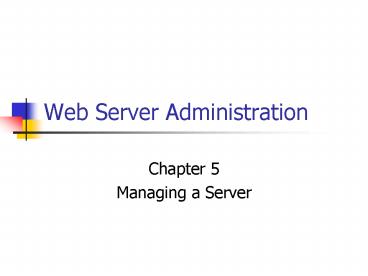Web Server Administration - PowerPoint PPT Presentation
1 / 23
Title:
Web Server Administration
Description:
Web server software is a product that works with the operating system ... When you access resources on another computer, your computer is acting as a client ... – PowerPoint PPT presentation
Number of Views:48
Avg rating:3.0/5.0
Title: Web Server Administration
1
Web Server Administration
- Chapter 5
- Managing a Server
2
Overview
- Understand the Web server administrator's view of
server management - Examine networking models
- Learn how users are authenticated
- Manage users and groups
3
Overview
- Manage file system permissions
- Share resources in a network
- Enforce network policies
4
Web Administrator's View of Server Management
- Web server software is a product that works with
the operating system - The server computer can run more than one
software product such as e-mail and FTP - With both a LAN and the Web, controlling access
is very important - The Web server can be part of the LAN
- Web communication and LAN communication are
different
5
Microsoft LAN Networking Models-Workgroup
- Treats each computer in the network as an equal,
or peer - Also called peer-to-peer networking
- Each computer is a client and a server
- When you allow others to access resources on your
computer, your computer is acting as a server - When you access resources on another computer,
your computer is acting as a client
6
Microsoft LAN Networking Models-Workgroup
- Appropriate for networks with 10 or less
computers - A number of disadvantages
- Most users do not want to administer resources on
their computer - Need user names and passwords of users who need
resources - Difficult to keep track of changing passwords
7
Microsoft LAN Networking Models-Domain
- One or more servers centralize control
- Computers are part of a domain
- Single, centralized logon
- Single point of control
- Users can be given access to resources anywhere
in the domain
8
Client/Server Networking Model
- Client represents a program such as a browser or
an e-mail client - Server has a corresponding program that
communicates with the client - Server program known as a service in Windows or a
daemon in Linux - Networking in Linux follows the client/server
model - Telnet is used to log on to another computer
9
Authenticating Users
- Process of determining a user's true identity
- Three basic methods
- What you know user name and passwords
- What you have entry card
- Who you are biometrics
10
Implementing an Authentication System
- If a Windows network has older computers running
NT, 95, or 98, the server must use NTLM - It is not as secure as Kerberos, which is the
default for Windows 2000, 2003, and XP
11
Managing Users and Groups
- Users need accounts to access resources on a
server - On a Web server there is a restricted account
that is used on behalf of Internet users - In a LAN, users with common resource needs are
put in a group, and the group is given access to
the resource
12
Managing Users and Groups in Windows
- Windows has an account called system
- It represents the operating system and it has
many of the same privileges of the administrator - Often needed by server programs
- Linux typically uses unique accounts for each
daemon
13
Users and Groups in Windows
- Local accounts exist on a single computer and can
be used to control resources only on that
computer - Domain accounts can be used to control resources
on all the computers that are part of the domain - Active Directory (AD) allows domains to be
grouped into a forest - Microsoft Exchange requires AD
14
Groups in Windows
- Domain local groups have members from the same
domain - Assign permissions to resources in the same
domain - Global groups have members from the same domain
- Can be used to assign permissions to resources in
any domain - Universal groups can have members from any domain
- Can be used to assign permissions to resources in
any domain
15
Users and Groups in Linux
- Properties of user accounts
16
File System Permissions
- Permission allow you to control access to the
resources on a computer such as a Web page, a
document, or a program - In Windows, the NTFS file system is required in
order to assign permissions - All Linux file systems incorporate permissions
17
File System Permissions in Windows
18
File System Permissions in Linux
19
Linux Permissions
- Permissions are set for user, group, and others
- Each permission is set with a single digit from 0
to 7 based on the combination of permissions - read 4
- write 2
- execute 1
20
Using chmod to Set Permissions
21
Sharing Resources in a Windows Network
- Shared folders require permissions
- When comparing share permissions and NTFS
permissions, the most restrictive permission
takes precedence
22
Enforcing Network Policies
- You can control a number of policies in both
Windows and Linux - Windows has many more policies but the majority
are appropriate for LANs - A common policy involves passwords
- Number of days before change allowed
- Number of days before change required
23
Summary
- The Web server has a guest user account that is
used to access Web pages - Windows LAN models include the workgroup and
domain models - Linux only uses the client/server model
- Authentication is based on what you know, what
you have, and who you are - Core of security incorporates users, groups, and
permissions































